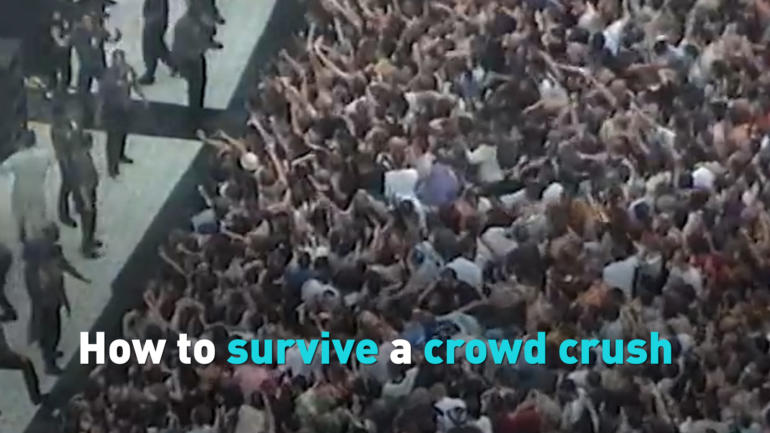The scenes from the Halloween crowd crush that killed more than 150 people in Seoul on Oct. 29 are gut-wrenching. As investigators continue to fault for an inadequate response, the reality is that any time large numbers of people gather in a confined space, there is potential for great harm.
To better prepare and respond if you find yourself in similar situations, it’s important to understand crowd density and be able to spot when it gets too tight.
A human being takes up an oval floorspace that’s about one foot by two feet or about one-fifth of a square meter.
Crowd density measures how many people are in a square meter of any crowd — and it is the best predictor of potential injury or death.
When the density is just two people per square meter, both can move freely without touching one another, and any crowd-related injury is basically zero, writes Tracy Hresko Pearl in a 2016 paper in the Kentucky Law Journal.
Even in a crowd with three or four people per square meter, it’s still pretty low risk for injury.
The critical turning point is once the crowd reaches 5 people in a square meter.
At this density, movement is far more limited, and the chances for injury or being trampled increase.
Once a crowd reaches six or seven people per square meter, people are pressed against each other so tightly they cannot move and a crowd-related injury risks are extremely high.
At this density, something significant happens.
The crowd begins to take on characteristics that are often associated with fluid dynamics. Essential the crowd starts to behave like liquid where people can be pushed quickly in any direction based on where forces are coming from, and it’s nearly impossible to stop once it begins.
Some also call this a “crowd quake” where shock waves of 12 meters or more can ripple through the crowd, lifting people out of their shoes or even clothing, Pearl writes.
There’s even been evidence of bent steel railings after several fatal crowd incidents that shows that crowds can produce a force of more than 1,000 pounds at a time, Pearl writes.
When you add to this, anxiety among an increasingly tight crowd, heat from surrounding bodies can cause people to faint and fall, and it the density makes it nearly impossible for others to help them. Often the only way to aid those who are ill is to lift them above the crowd and pass them overhead to safety.
In the worst case scenario, people in extremely dense crowds can suffer from “compressive asphyxiation” or being suffocated to death while standing due to the force of the crowd surrounding them.
Because crowd density can essentially predict if people live or die, it’s important for cities, venues, government and every person in a crowd to understand to stay safe.
BEFORE A CRUSH: Notice early warning signs
One of the first things to notice in a large crowd is if there are not sufficient organizers or public safety present.
The earliest warning of a crowd crush is the absence of control measures such as barriers, signs, loudspeakers, and a lack of organizers or police officers, according to a Slate article.
In the South Korean incident, the first call to police took place hours before the crush from a woman who had been separated from her family and said a police officers there were overwhelmed.
Be aware of your situation at all times, says crowd expert Keith Still.
Still says its important to look at all the spaces in front of and behind you, make sure you know where exit points are, and if it begins to get uncomfortable, step away.
Don’t just think of where you entered, as that spot may not be the safest once a crowd increases, says crowd safety expert Paul Wertheimer. Always be on the lookout for alternate exits in an emergency such as windows and fire exits or fences you can climb over or temporary barriers you can cross.
Once you start to feel other people on all four sides of you the density is getting higher. While this may not be dangerous, consider moving away from the mass, remembering or looking out for those exit points.
DURING A CRUSH: Tips to stay safe
If you can’t easily escape the crowd try your hardest to stay standing. In a tight crowd, one person falling and cause a domino effect on those around them. Try to help other people stay standing too.
If you can keep your hands at your chest, like a boxer, this protects your rib cage and keeps a space around your lungs so you can breathe.
If you fall, curl into a ball and cover your head.
Do not push at the crowd, even if you are pushed. It wastes energy that you need to save.
Don’t scream unless you have to, and control your breaths. Try to use non-verbal cues to communicate with others.
In a crush, a main cause of injury is the lack of information going from people in the front of a crowd to those further out. Look for people who might be in a higher position such as on a platform or in buildings above who can give you information on what’s ahead. Also look up to see if they are any escape points from above.
Try to figure out where the center of the crowd is to avoid it.
Stay away from the most dangers places in a crowd — any area that further restricts movement such as doorways, bridges, hallways, or narrow spaces where the force of the crowd will only increase.
DURING A SURGE IN A CRUSH: Know this important survival tip
If you are already in the worst case scenario of a “crowd quake” use this technique.
After a large crowd push there’s always a brief lull, says Wertheimer. It’s in these moments that you should try to move diagonally or zig zag between pockets of people.
Try to keep working your way diagonally between people between each surge. This can help get you to the periphery of the crowd.
 CGTN America
CGTN America

